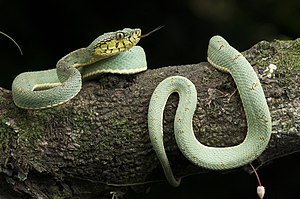Green jararaca
| Green jararaca | ||||||||||||
|---|---|---|---|---|---|---|---|---|---|---|---|---|

Green Jararaca ( Bothrops bilineatus ) |
||||||||||||
| Systematics | ||||||||||||
|
||||||||||||
| Scientific name | ||||||||||||
| Bothrops bilineatus | ||||||||||||
| ( Wied-Neuwied , 1821) |
The green Jararaca ( Bothrops bilineatus , Syn .: Bothriopsis bilineata ) is a viper species from the subfamily of pit vipers and belongs to the genus of the American lance viper ( Bothrops ).
features
Bothrops bilineatus reaches a total length between 80 and 120 cm. The body is slim but strong. The tail is pronounced as a prehensile tail. The head broad, triangular in shape when viewed from above and clearly set off from the neck. The eye is yellowish green to dark green and has a pupil that is vertically slit when exposed to light. The basic color of the body is green to bluish-green. Along the sides of the middle of the back there are around 40 golden-yellow, small spots, each of which is formed by a few (mostly 2) appropriately colored scales. On the side of the body over the paraventral scales (row of flank scales at the transition to the ventral shields) a yellowish stripe is visible. The specific epithet “bilineatus” (Latin “bi” - “two”, “lineatus” - “striped”, one stripe on each side of the body) refers to this . The subspecies Bothrops bilineatus smaragdinus also has numerous small dots on the scales of the head and body. The venom apparatus consists of venom glands located on the side of the skull (specialized salivary glands ) and movable fangs located in the anterior upper jaw (solenoglyph tooth position).
Pholidosis
The pholidosis (scaling) shows the following characteristics:
- 7 to 9 upper lip shields ( supralabials ),
- 8 to 12 lower lip shields ( Scuta sublabialia ),
-
Scuta ocularia :
- 2 front eye shields (Scuta vorocularia),
- 2 posterior eye shields (Scuta postocularia),
- Scales of temples weakly keeled,
- 23 to 35 rows of elongated and keeled trunk scales ( Scuta dorsalia ),
- 192 to 220 abdominal shields ( Scuta ventralia ), divided, partly undivided, and
- 55 to 76 under tail shields ( Scuta subcaudalia ).
Systematics
The first description was made in 1821 by the naturalist Maximilian zu Wied-Neuwied under the name Cophias bilineatus . The species has long been, and is partly still currently (status: 2018), assigned to the genus Bothriopsis as Bothriopsis bilineata . The exact systematics or cladistics of the genera Bothrops and Bothriopsis is the subject of research and has not been conclusively clarified. Thus, the status of Bothrops bilineatus is also relatively uncertain. Starace (1998), Feio & Caramaschi (2003), Claessen (2006) and Carrasco et al. (2012) introduced the Green Jararaca within the genus Bothrops . Fenwick et al. (2009) and Wallach et al. (2014) listed the species as Bothriopsis bilineata as part of a breakdown of the genus Bothrops , including on the basis of molecular biological studies .
Two subspecies are listed:
- Bothrops bilineatus bilineatus ( Wied 1821)
- Bothrops bilineatus smaragdinus Hoge 1966
distribution
The distribution area includes areas within South America in Brazil ( Bahia , Minas Gerais , Amazonas , Mato Grosso , Rondônia , Espírito Santo and others), Venezuela , Colombia , Ecuador , Bolivia , Peru , Guyana , Suriname and French Guiana . The populated biotopes are represented by humid tropical forests. The species is regularly found in palm trees such as Cocos bothryophora or Diplothenium caudescens .
Way of life

Bothrops bilineatus leads a climbing and largely nocturnal way of life. It is rarely found in holes in the ground. The species is often found in the branches of bushes and trees at heights of up to 3 meters. The range of prey includes frogs , small birds and mammals and lizards . After the venomous bite has occurred, the prey is usually held between the jaws until immobilization occurs. The propagation is done by ovoviviparity , so egg-viviparous. A litter can contain 6 to 12 juvenile snakes.
Snake venom
The poison secretion of Bothrops bilineatus contains, among other things, fibrinogenases . It may also contain cytotoxins , hemorrhagins ( blood vessel-damaging metalloproteases ) and myotoxins . Local swelling , blistering , necrosis , coagulopathy and bleeding are significant symptoms of poisoning after poison bite by Bothrops bilineatus . Various antivenins , such as 'Polyvalent Antivenom' (Instituto Clodomiro Picado, Costa Rica) or 'Soro antibotropico-laquetico' (Instituto Butantan, Brazil), are available for therapy.
The poison bite of the Green Jararaca is considered to be less dangerous than in the case of some related species of the genera Bothrops and Bothriopsis . A quick medical assessment is advisable, however, fatal poisoning by the species cannot be ruled out. Due to the climbing lifestyle, bites mostly occur in the arms, upper body or head region.
Individual evidence
- ↑ a b c Bothrops bilineatus in The Reptile Database (accessed July 6, 2018)
- ↑ a b c University of Adelaide, Clinical Toxinology Resources: Bothrops bilineatus (accessed July 6, 2018)
literature
- Ludwig Trutnau: Snakes in the Terrarium Vol. 2: Poisonous snakes . Verlag Ulmer, Stuttgart 1998, ISBN 3-800-1705-23 .